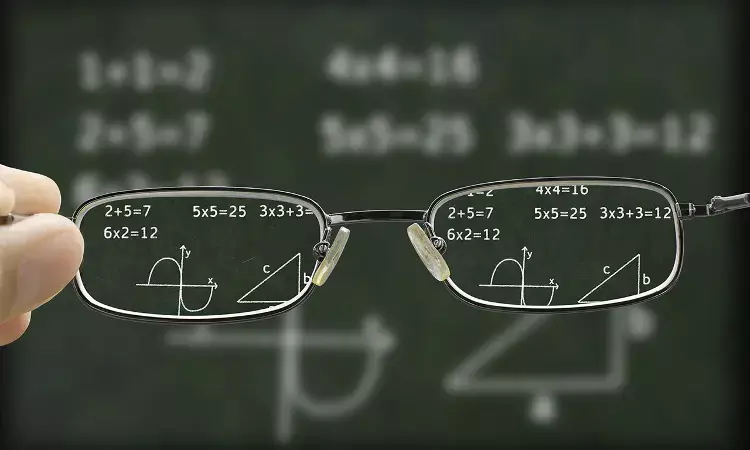- Home
- Medical news & Guidelines
- Anesthesiology
- Cardiology and CTVS
- Critical Care
- Dentistry
- Dermatology
- Diabetes and Endocrinology
- ENT
- Gastroenterology
- Medicine
- Nephrology
- Neurology
- Obstretics-Gynaecology
- Oncology
- Ophthalmology
- Orthopaedics
- Pediatrics-Neonatology
- Psychiatry
- Pulmonology
- Radiology
- Surgery
- Urology
- Laboratory Medicine
- Diet
- Nursing
- Paramedical
- Physiotherapy
- Health news
- Fact Check
- Bone Health Fact Check
- Brain Health Fact Check
- Cancer Related Fact Check
- Child Care Fact Check
- Dental and oral health fact check
- Diabetes and metabolic health fact check
- Diet and Nutrition Fact Check
- Eye and ENT Care Fact Check
- Fitness fact check
- Gut health fact check
- Heart health fact check
- Kidney health fact check
- Medical education fact check
- Men's health fact check
- Respiratory fact check
- Skin and hair care fact check
- Vaccine and Immunization fact check
- Women's health fact check
- AYUSH
- State News
- Andaman and Nicobar Islands
- Andhra Pradesh
- Arunachal Pradesh
- Assam
- Bihar
- Chandigarh
- Chattisgarh
- Dadra and Nagar Haveli
- Daman and Diu
- Delhi
- Goa
- Gujarat
- Haryana
- Himachal Pradesh
- Jammu & Kashmir
- Jharkhand
- Karnataka
- Kerala
- Ladakh
- Lakshadweep
- Madhya Pradesh
- Maharashtra
- Manipur
- Meghalaya
- Mizoram
- Nagaland
- Odisha
- Puducherry
- Punjab
- Rajasthan
- Sikkim
- Tamil Nadu
- Telangana
- Tripura
- Uttar Pradesh
- Uttrakhand
- West Bengal
- Medical Education
- Industry
Patient-Reported Dry Eye Symptoms Improve Six Months post FS-LASIK

In a recent study, Sloan Rush and colleagues patient-reported dry eye symptoms show a notable improvement six months after the femtosecond LASIK (FS-LASIK) for myopia, despite the lack of significant changes in objective dry eye measurements. The findings of the study were published in Clinical Ophthalmology.
To assess the impact of FS-LASIK on dry eye symptoms, the researchers enrolled 40 patients who underwent bilateral myopic FS-LASIK. The patients were asked to complete a standardized Dry Eye Symptom Index survey both before the treatment and at the six-month mark post-surgery. This survey utilized an analog scoring system ranging from 1 to 5, with 5 representing the most severe symptoms. Additionally, objective measurements such as the objective scatter index (OSI), tear film osmolarity (TFO), and automated tear break-up times (TBUT) were recorded for each patient.
The results of the study demonstrated a significant improvement in patient-reported dry eye symptoms. Prior to FS-LASIK, the Dry Eye Symptom Index score averaged 2.3 (with 95% Confidence Intervals between 2.0 and 2.6). However, at the six-month follow-up, this score had notably decreased to 1.3 (with 95% Confidence Intervals between 1.0 and 1.5), signifying a substantial amelioration in dry eye symptoms. The statistical analysis confirmed that this improvement was highly significant (p < 0.0001).
Further investigation through subset analysis revealed that specific symptoms related to dry eye also experienced improvement. Patients reported significant enhancement in "grittiness" (p = 0.001) after the procedure. However, no significant changes were noted in the symptoms of "light sensitivity" or "soreness" (p = 0.13 and p = 0.24, respectively).
Surprisingly, despite the remarkable improvement in patient-reported outcomes, objective measurements related to dry eye did not exhibit significant changes at the six-month mark (p > 0.05 for all). The OSI, TFO, and TBUT remained relatively stable throughout the study period.
Fortunately, the research team reported no adverse events or complications associated with FS-LASIK during the entire study period. This reinforces the safety and viability of the procedure as a treatment for myopia.
Source:
Rush, S., Pickett, C. J., & Rush, R. B. (2023). Patient-Reported Dry Eye Outcomes After Myopic Femtosecond-LASIK: A 6-Month Prospective Analysis. In Clinical Ophthalmology: Vol. Volume 17 (pp. 2141–2147). Informa UK Limited. https://doi.org/10.2147/opth.s421369
Neuroscience Masters graduate
Jacinthlyn Sylvia, a Neuroscience Master's graduate from Chennai has worked extensively in deciphering the neurobiology of cognition and motor control in aging. She also has spread-out exposure to Neurosurgery from her Bachelor’s. She is currently involved in active Neuro-Oncology research. She is an upcoming neuroscientist with a fiery passion for writing. Her news cover at Medical Dialogues feature recent discoveries and updates from the healthcare and biomedical research fields. She can be reached at editorial@medicaldialogues.in
Dr Kamal Kant Kohli-MBBS, DTCD- a chest specialist with more than 30 years of practice and a flair for writing clinical articles, Dr Kamal Kant Kohli joined Medical Dialogues as a Chief Editor of Medical News. Besides writing articles, as an editor, he proofreads and verifies all the medical content published on Medical Dialogues including those coming from journals, studies,medical conferences,guidelines etc. Email: drkohli@medicaldialogues.in. Contact no. 011-43720751


